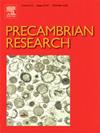Neoproterozoic paleogeography and displacement of the Mongolian blocks constrained by detrital zircon ages and Hf isotopic systematics (Zavkhan Block, W Mongolia)
IF 3.2
2区 地球科学
Q2 GEOSCIENCES, MULTIDISCIPLINARY
引用次数: 0
Abstract
This study presents results of provenance analysis based on U–Pb ages and Hf isotopic composition of detrital zircons from (meta-)sedimentary rocks of two sections of the Zavkhan Block in W Mongolia. Detrital zircon age populations for most of the studied samples show a dominant Tonian–Cryogenian peak (c. 750 Ma), considered as detritus derived from the local rift-related magmatic sources. Some samples also have significant Neoarchean–Paleoproterozoic (c. 2.7–1.7 Ga) zircons sourced from cratonic basement. The large range of εHf(t) values (–30 to +15) of the Tonian–Cryogenian zircons indicates significant mixing of mantle-derived magmas with mature crustal material, interpreted as a result of crustal melting during rifting. The Hf isotopic composition of the older zircons suggests contributions from both juvenile magmas and crustal recycling. Maximum depositional ages indicate that although dominantly Tonian–Cryogenian, the studied sequences also include subordinate older (pre-rift) stratigraphic members. The zircon age and Hf isotopic systematics of the younger part of studied rocks are interpreted to reflect sedimentation in Tonian–Cryogenian post-rift sequences evolving towards continental passive margin during the break-up of Rodinia. On the other hand, the pre-Tonian detritus from post-rift strata were dominantly recycled directly from the older pre-rift strata or indirectly from the Tonian anatectic magmatic rocks. These data are correlated with corresponding datasets from potential cratonic sources, which indicate close similarity and possible paleogeographic connection of the Zavkhan Block to the western Siberian Craton. Thus, it is proposed that the Zavkhan Block together with other Mongolian continental fragments were rifted from western Siberia in the Tonian–Cryogenian. The whole archipelago was subsequently dextrally translated along the Siberian margin into its Ediacaran–early Paleozoic position south of the Siberia Craton.

碎屑锆石年龄与Hf同位素系统约束下蒙古Zavkhan地块新元古代古地理与位移
本文介绍了蒙古西部扎夫汗地块2段(变)沉积岩碎屑锆石U-Pb年龄和Hf同位素组成的物源分析结果。大多数研究样品的碎屑锆石年龄群显示出一个主要的托尼-低温期峰值(约750 Ma),被认为是来自当地与裂谷有关的岩浆源的碎屑。部分样品还含有来自克拉通基底的新太古代-古元古代(约2.7-1.7 Ga)锆石。东—低温系锆石εHf(t)值范围大(-30 ~ +15),表明幔源岩浆与成熟地壳物质混合作用明显,可能是裂陷期地壳熔融作用的结果。较老锆石的Hf同位素组成表明,锆石既有年轻岩浆的贡献,也有地壳再循环的贡献。最大沉积年龄表明,研究的层序虽然以托尼-低温系为主,但也包括次古(裂谷前)层序。研究岩石年轻部分的锆石年龄和Hf同位素系统解释反映了罗迪尼亚分裂时期向大陆被动边缘演化的托尼-低温系裂谷后序列的沉积作用。另一方面,裂谷后地层的前托尼期碎屑主要是直接来自更老的前裂谷地层或间接来自托尼期的清灰岩浆岩。这些数据与潜在克拉通源的相应数据进行了对比,表明扎夫汗地块与西伯利亚克拉通具有密切的相似性和可能的古地理联系。因此,我们认为扎夫汗地块与其他蒙古大陆碎片是在托尼-低温世从西伯利亚西部裂化而来的。整个群岛随后沿着西伯利亚边缘被右平移到西伯利亚克拉通以南的埃迪卡拉-早古生代位置。
本文章由计算机程序翻译,如有差异,请以英文原文为准。
求助全文
约1分钟内获得全文
求助全文
来源期刊

Precambrian Research
地学-地球科学综合
CiteScore
7.20
自引率
28.90%
发文量
325
审稿时长
12 months
期刊介绍:
Precambrian Research publishes studies on all aspects of the early stages of the composition, structure and evolution of the Earth and its planetary neighbours. With a focus on process-oriented and comparative studies, it covers, but is not restricted to, subjects such as:
(1) Chemical, biological, biochemical and cosmochemical evolution; the origin of life; the evolution of the oceans and atmosphere; the early fossil record; palaeobiology;
(2) Geochronology and isotope and elemental geochemistry;
(3) Precambrian mineral deposits;
(4) Geophysical aspects of the early Earth and Precambrian terrains;
(5) Nature, formation and evolution of the Precambrian lithosphere and mantle including magmatic, depositional, metamorphic and tectonic processes.
In addition, the editors particularly welcome integrated process-oriented studies that involve a combination of the above fields and comparative studies that demonstrate the effect of Precambrian evolution on Phanerozoic earth system processes.
Regional and localised studies of Precambrian phenomena are considered appropriate only when the detail and quality allow illustration of a wider process, or when significant gaps in basic knowledge of a particular area can be filled.
 求助内容:
求助内容: 应助结果提醒方式:
应助结果提醒方式:


